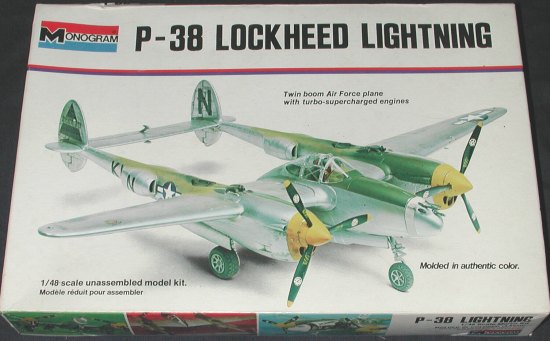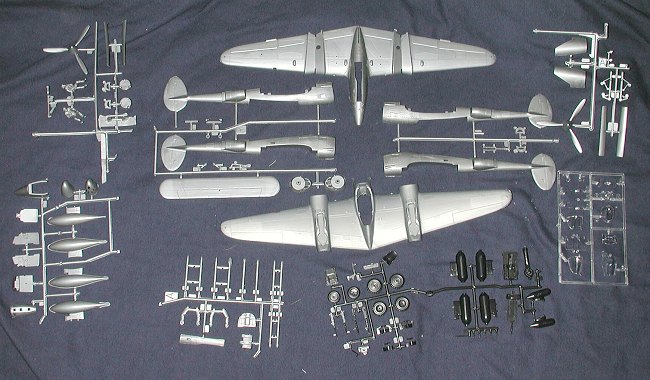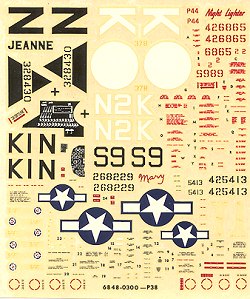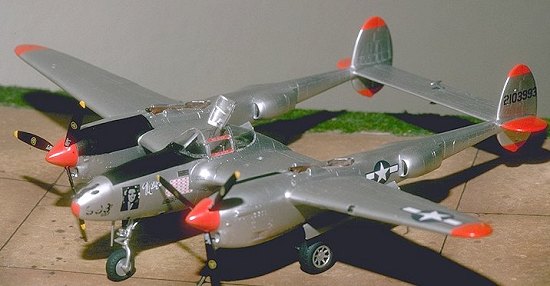
|
KIT: |
Monogram 1/48 P-38 Lightning |
|
KIT # |
6848 |
|
PRICE: |
? |
|
DECALS: |
Four aircraft |
|
REVIEWER: |
|
|
NOTES: |
1973 boxing - First released in 1966 |

|
HISTORY |
Equipped with droppable fuel tanks under its wings, the P-38 was used extensively as a long-range escort fighter and saw action in practically every major combat area of the world. A very versatile aircraft, the Lightning was also used for dive bombing, level bombing, ground strafing and photo reconnaissance missions.
|
THE KIT |

I guess you could call this a 'flower-child' kit, being first released in 1966. For its day, an even now, it was an incredibly detailed kit. Monogram was shaking off the 'everything must work' syndrome of the earlier times and was concentrating on providing the most accurate kit possible. Yes, the detail is raised. Yes, it has some rivets. But all in all, it is a remarkably accurate model. What is more, it can be built in a number of different ways. From the original kit, one can build a standard fighter, the late war night fighter, the photo recon version or the pathfinder version with the bombardier nose. To do these other variants requires some cutting of the gun access doors to open up the areas for the windows. The kit also provides drop tanks and rocket racks as well as bombs.
 The cockpit is well detailed for its time with a decal for the instrument panel.
One also gets the option to
hinge the canopy and to hinge the gun access panel as well. I can tell you from
experience, that both are a bit difficult, especially the gun access cover. This
kit is a major tail sitter so you'll need a lot of weight to keep it on its
nose. This can be added into the engine areas as the gun bay will be unavailable
if you have the guns installed and too easily seen on the pathfinder version. I
should point out that my example suffered from some flash, ejector pin marks and
some sink marks; all typical of kits of this era.
The cockpit is well detailed for its time with a decal for the instrument panel.
One also gets the option to
hinge the canopy and to hinge the gun access panel as well. I can tell you from
experience, that both are a bit difficult, especially the gun access cover. This
kit is a major tail sitter so you'll need a lot of weight to keep it on its
nose. This can be added into the engine areas as the gun bay will be unavailable
if you have the guns installed and too easily seen on the pathfinder version. I
should point out that my example suffered from some flash, ejector pin marks and
some sink marks; all typical of kits of this era.
Instructions are quite good telling you of all the needed changes to be made for the different variants as well as some hints and tips on construction. The decal sheet, though not in the best of condition, has markings for four aircraft. The box top plane is a P-38L coded KI*N in bare metal. A camouflaged P-38J, N2*K is also provided. A No unit info is given for any of the markings. The night fighter version is in black, while the recce plane is in bare metal and coded S9. Finally, the patherfinder is in bare metal with no codes at all. Decals are well printed, but since older Monogram decals are generally, well, less than optimal, most modelers will go for aftermarket ones.
|
CONCLUSIONS |
 Though
completely out-done by the more modern kits by Hasegawa and Academy, the
Monogram kit offers a lot more in terms of options. I'm not sure if all the
other variants are provided by the more recent releases of this kit, but with
time and patience, it can be made into a very nice model, as you can see from
the image of one I did straight from the box about 10 years ago.
Though
completely out-done by the more modern kits by Hasegawa and Academy, the
Monogram kit offers a lot more in terms of options. I'm not sure if all the
other variants are provided by the more recent releases of this kit, but with
time and patience, it can be made into a very nice model, as you can see from
the image of one I did straight from the box about 10 years ago.
If you would like your product reviewed fairly and quickly by a site that has 200,000 visitors a month, please contact me or see other details in the Note to Contributors.